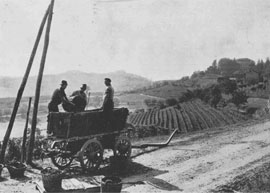Barbera Project - Story of Barbera
 While Barbera Vigna Vecchia is at rest in its barrel, Daniela Vinciguerra tells us the story of this traditional Piedmontese wine:
While Barbera Vigna Vecchia is at rest in its barrel, Daniela Vinciguerra tells us the story of this traditional Piedmontese wine:
 No other red wine of Italy has risen so rapidly in favor in recent times as Barbera. Still, despite mounting praise from critics and connoisseurs, the ascent has scarcely begun. What sets Barbera apart from other red wine varieties on the Piedmont is its extraordinary promise, the potential to eventually satisfy world demands in terms of both quality and quantity. Barbera, which covers half of the region’s vineyards, symbolizes Piedmontese viticulture. It is also appreciated in other regions, but there’s non question that Barbera reaches peaks in the Monferrato, in the southern hills of Piedmont, where wines from certain vineyards reveal attributes of colour, body, bouquet and flavour that are unmatched elsewhere. It has been said that the grape, more than any other fruit, succeeds in transmitting the character of land in which it is cultivated. The Barbera grape does much more. It manages to express the essential character of the Piedmontesi: stubborn, direct, tied to family tradition and yet open to those innovations which permit them to maintain their own unique qualities. Accounts of the old-style Barbera often described its vigour and zest and a certain rustic tag. Yet, despite the reputation for robustness, many Piedmontese refer to ‘la Barbera’ in the feminine gender, one of the few wines on Italy to rate that consideration. Barbera’s origins are not clear, though the vine rose to prominence in the last century. It has always been held in greatest esteem in the provinces of Asti and Alessandria, in its native Monferrato hills. Its stock rose further after the scourge of phylloxera, which devastated Europe’s vineyards around the turn of the century. Farmers replanted with vines that thrived in various conditions of climate and soil, that proved to be resistant to maladies and were, above all, consistently productive. Barbera, more than any other variety, met the requirements.
No other red wine of Italy has risen so rapidly in favor in recent times as Barbera. Still, despite mounting praise from critics and connoisseurs, the ascent has scarcely begun. What sets Barbera apart from other red wine varieties on the Piedmont is its extraordinary promise, the potential to eventually satisfy world demands in terms of both quality and quantity. Barbera, which covers half of the region’s vineyards, symbolizes Piedmontese viticulture. It is also appreciated in other regions, but there’s non question that Barbera reaches peaks in the Monferrato, in the southern hills of Piedmont, where wines from certain vineyards reveal attributes of colour, body, bouquet and flavour that are unmatched elsewhere. It has been said that the grape, more than any other fruit, succeeds in transmitting the character of land in which it is cultivated. The Barbera grape does much more. It manages to express the essential character of the Piedmontesi: stubborn, direct, tied to family tradition and yet open to those innovations which permit them to maintain their own unique qualities. Accounts of the old-style Barbera often described its vigour and zest and a certain rustic tag. Yet, despite the reputation for robustness, many Piedmontese refer to ‘la Barbera’ in the feminine gender, one of the few wines on Italy to rate that consideration. Barbera’s origins are not clear, though the vine rose to prominence in the last century. It has always been held in greatest esteem in the provinces of Asti and Alessandria, in its native Monferrato hills. Its stock rose further after the scourge of phylloxera, which devastated Europe’s vineyards around the turn of the century. Farmers replanted with vines that thrived in various conditions of climate and soil, that proved to be resistant to maladies and were, above all, consistently productive. Barbera, more than any other variety, met the requirements.
 In the Asti and Monferrato areas the agricultural practices of the early part of the century were more heterogeneous. Once the grapes harvest was completed there was little time to dedicate to the fermentation process. This urgency was dictated by the necessity to sow cereals. In Novembre the fermenting must was abandoned in the vats; under such conditions the wine inevitably deteriorated due to acescence and became undrinkable. The necessity to cultivate grapes which could guarantee a wine immune (or nearly immune) to the dangers of alteration was imperative. This was barbera’s fortune. Its acidic constitution created a barrier against the very bacteria which would have destroyed an entire years’ labour. Todays, Barbera’s role is changing. Until twenty years ago it was classified as a common table wine of no notable quality. Now it is commonly referred to as the Piedmont’s premiere wine for the third millennium, a product destined to rank with wines topping the international classifications. Once, a certain alcoholometric degree and a notable acidity were prerequisites for a wine which could withstand ageing. Now these are not the only factors that play an important role. The I.D. of a wine demands more detail: it should possess intense colour, an enveloping fragrance, a supple and elegant taste. But, that is not enough. From quality wine we want a well defined territory of origin, an important history and evidence that it has long been part of local rural tradition. Barbera possesses all of these characteristics, but does not always show them. The original grape expresses itself best only in its preferred territory, the Piedmont. And it is thanks to barbera that the Piedmont can compete with Burgundy, Europe’s most important wine producing region.
In the Asti and Monferrato areas the agricultural practices of the early part of the century were more heterogeneous. Once the grapes harvest was completed there was little time to dedicate to the fermentation process. This urgency was dictated by the necessity to sow cereals. In Novembre the fermenting must was abandoned in the vats; under such conditions the wine inevitably deteriorated due to acescence and became undrinkable. The necessity to cultivate grapes which could guarantee a wine immune (or nearly immune) to the dangers of alteration was imperative. This was barbera’s fortune. Its acidic constitution created a barrier against the very bacteria which would have destroyed an entire years’ labour. Todays, Barbera’s role is changing. Until twenty years ago it was classified as a common table wine of no notable quality. Now it is commonly referred to as the Piedmont’s premiere wine for the third millennium, a product destined to rank with wines topping the international classifications. Once, a certain alcoholometric degree and a notable acidity were prerequisites for a wine which could withstand ageing. Now these are not the only factors that play an important role. The I.D. of a wine demands more detail: it should possess intense colour, an enveloping fragrance, a supple and elegant taste. But, that is not enough. From quality wine we want a well defined territory of origin, an important history and evidence that it has long been part of local rural tradition. Barbera possesses all of these characteristics, but does not always show them. The original grape expresses itself best only in its preferred territory, the Piedmont. And it is thanks to barbera that the Piedmont can compete with Burgundy, Europe’s most important wine producing region.








